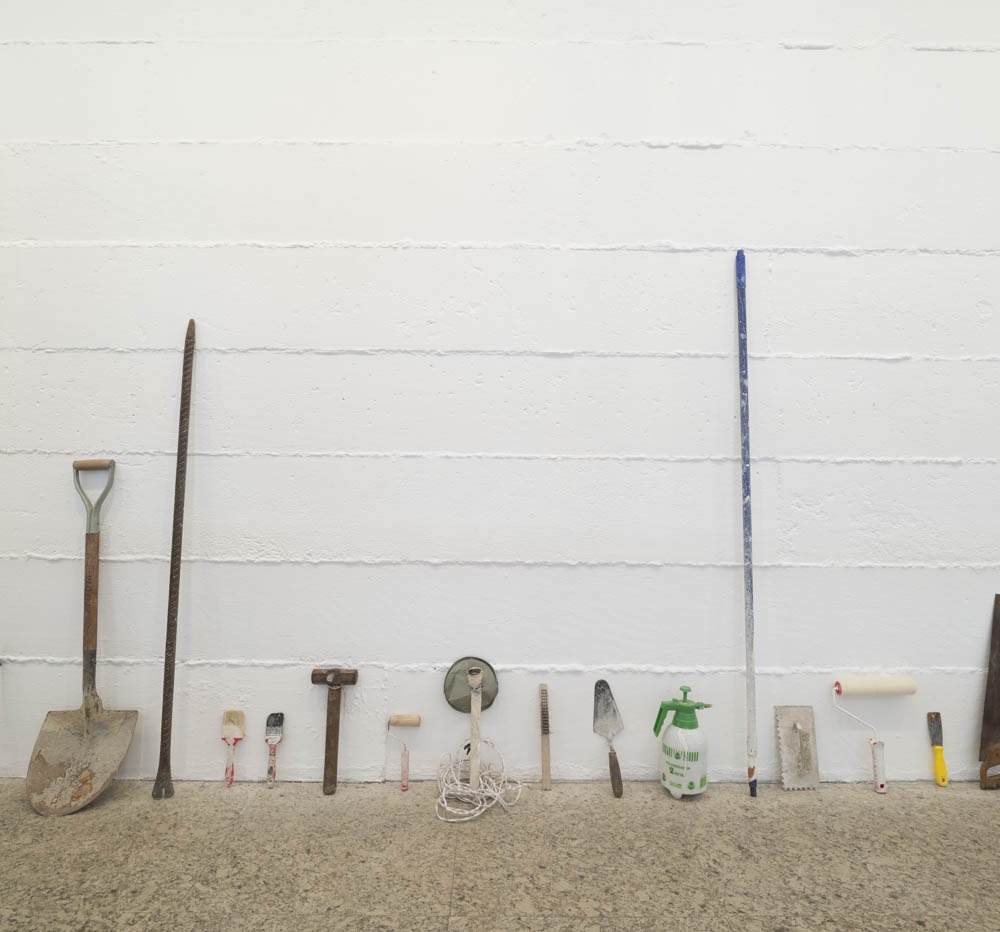Thiago Honório
Work
12 Aug 2016 - 29 Jan 2017
Trabalho [Work] (2013/16) arose based on a set of professional, personal and affective relationships between Thiago Honório and a group of civil construction workers. The artist negotiated with cement workers and construction foremen to either barter or donate their work instruments or tools that now make up this installation. They are shovels, chisels, ladders, pickaxes, hoes, mauls, trowels, saws, sickles, paint rollers, brushes, spatulas and other tools that were used in the restoration of an old supply station that belonged to the electrical power company by the name of Light, a building built in the 1920s at Bandeira Square in downtown São Paulo, now transformed into the Red Bull Station cultural center.
Begun in the context of an artist’s residency, Thiago Honório’s work shuffles the places and meanings of art: transiting through the hands of workers, in the operation of displacement brought about by the artist, in the restoration made with the tools, and finally in the architecture of the space where it is now installed. From an ethical point of view, the artist understood that the receipt of what he calls “gifts,” from the workers, could only result in a donation of Trabalho to a museum, and that is how it arrived at MASP. The rough, raw and cold appearance of the tools-elements of Trabalho contrasts with the traditional perception of the “fine arts,” but is also aligned with the characteristics of the museum building’s brutalist architecture with its apparent, uncovered structural elements and lack of luxury finishings (while also contrasting with the refined architecture of traditional fine arts museums).
There is a complex metalinguistic operation underway – the workers’ tools refer to those of the sculptor, except that here they themselves have become sculptures. On the other hand, tools displayed standing up assume an anthropomorphic verticality (referring to the form of the human body), which winds up representing, metonymically, the workers who once possessed them (metonymy is a figure of speech that substitutes a subject or object by something closely related to it). We are therefore observing a lineup of workers’ portraits, which becomes particularly relevant when we remember that the ground-level plaza under MASP’s clear span has hosted all sorts of manifestations and protests by workers of every sort.
The presence of Thiago Honório’s work has everything to do with the current concerns of the museum’s programming, in regard to the critical revision of not only artists, but also of techniques, languages and modes of production that were left aside, eclipsed by the hegemonic narratives of the history of art, frequently for not being associated with the tastes, protocols and styles of the dominant classes. These questions are clearly present in the reenactement of A mão do povo brasileiro [The Hand of the Brazilian People] — the historical exhibition curated by Lina Bo Bardi in 1969, which will occupy the museum’s first floor beginning on September 1, 2016. Instead of art or artifact, Lina proposed the notion of work [trabalho] to apply to a painting by Candido Portinari just as much as to a tool, insofar as both are products of a human labor, hence the relevance of this Trabalho.
Begun in the context of an artist’s residency, Thiago Honório’s work shuffles the places and meanings of art: transiting through the hands of workers, in the operation of displacement brought about by the artist, in the restoration made with the tools, and finally in the architecture of the space where it is now installed. From an ethical point of view, the artist understood that the receipt of what he calls “gifts,” from the workers, could only result in a donation of Trabalho to a museum, and that is how it arrived at MASP. The rough, raw and cold appearance of the tools-elements of Trabalho contrasts with the traditional perception of the “fine arts,” but is also aligned with the characteristics of the museum building’s brutalist architecture with its apparent, uncovered structural elements and lack of luxury finishings (while also contrasting with the refined architecture of traditional fine arts museums).
There is a complex metalinguistic operation underway – the workers’ tools refer to those of the sculptor, except that here they themselves have become sculptures. On the other hand, tools displayed standing up assume an anthropomorphic verticality (referring to the form of the human body), which winds up representing, metonymically, the workers who once possessed them (metonymy is a figure of speech that substitutes a subject or object by something closely related to it). We are therefore observing a lineup of workers’ portraits, which becomes particularly relevant when we remember that the ground-level plaza under MASP’s clear span has hosted all sorts of manifestations and protests by workers of every sort.
The presence of Thiago Honório’s work has everything to do with the current concerns of the museum’s programming, in regard to the critical revision of not only artists, but also of techniques, languages and modes of production that were left aside, eclipsed by the hegemonic narratives of the history of art, frequently for not being associated with the tastes, protocols and styles of the dominant classes. These questions are clearly present in the reenactement of A mão do povo brasileiro [The Hand of the Brazilian People] — the historical exhibition curated by Lina Bo Bardi in 1969, which will occupy the museum’s first floor beginning on September 1, 2016. Instead of art or artifact, Lina proposed the notion of work [trabalho] to apply to a painting by Candido Portinari just as much as to a tool, insofar as both are products of a human labor, hence the relevance of this Trabalho.

